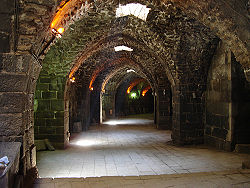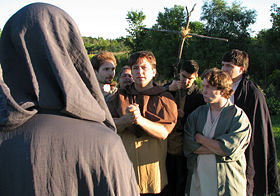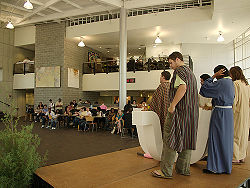Morality play
A Morality play is a type of dramatic allegory, performed in a theater, in which the protagonist is met by personifications of various moral attributes who try to prompt him to choose a godly life over one of evil. The protagonist him or herself is also, quite often, a personification of the entire human species, as is the case with characters such as Everyman and Mankind. The stories usually follow a path where the protagonist is tempted to sin by the antagonists and only through God does the protagonist find peace, salvation, or hope. The plays were most popular in Europe during the fifteenth and sixteenth centuries. Having grown out of the religiously based mystery plays and miracle plays of the Middle Ages, they represented a shift towards a more secular base for European theater.
Morality plays survived the disenchantment of the church and the wrath of the Reformation, maintaining their popularity to near the end of the sixteenth century, when the the public's interest turned in other directions. They are a representation of humankind's fascination with art and creativity and the desire to use those gifts to bring about positive ends.
History
The morality play has its roots in the miracle and mystery plays of the eleventh century.[1] Miracle plays were dramas that revolved around the lives of Saints or the Virgin Mary. Mystery plays revolved around stories from the Bible and were also known as Pageants or as Corpus Christi plays. Mystery plays were performed across Europe during the thirteenth to sixteenth centuries. Miracle plays were performed even earlier, often as a church service (until the thirteenth century, when they were separated from church services and could instead be seen performed at public festivals).[2] However, most miracle plays were lost in the zeal of the Reformation, when the scripts were burned and destroyed.
Morality plays rose from this tradition, and represent a transition between such religion-based plays to secular, professional theater. The earliest surviving example in English is the long Castle of Perseverance (c. 1420), and the best-known is Everyman (c.1510). By the dawn of the fifteenth century, morality plays were common throughout medieval Europe as didactic plays intended to teach good morals to their audience.
Morality plays were originally quite serious in tone and style, due to their roots in religious drama.[1] As time wore on and the plays became more secularized, they began to incorporate elements from popular farce. This process was encouraged by the representation of the Devil and his servant, the Vice, as mischievous trouble-makers. The Devil and the Vice soon became figures of amusement rather than moral edification. In addition, the Church noticed that the actors would often improvise humorous segments and scenes to increase the play's hilarity to the crowd. By roughly 1500, the Church no longer officially sanctioned the mystery, miracle, or morality plays.[1]
By the sixteenth century, these plays started to deal with secular topics, as medieval theater started to make the changes that would eventually develop it into Renaissance theater. As time moved, morality plays more frequently dealt with secular topics, including forms of knowledge (in Nature and The Nature of the Four Elements) questions of good government (Magnificence by John Skelton and Respublica by Nicholas Udall), education (Wit and Science by John Redford, and the two other "wit" plays that followed, The Marriage of Wit and Science and Wit and Wisdom), and sectarian controversies, chiefly in the plays of John Bale.
Morality plays survived, however, even through the Reformation in the sixteenth century, and only gradually died out as tastes changed towards the beginning of the seventeenth century. Throughout his career, which continued until the early seventeenth century, Shakespeare made references to morality characters and tropes, confirming that the form was still alive for his audiences, at least in memory, if not in practice.
Characteristics
A morality play is essentially an allegory, told through drama.[1] It shares the feature of allegorical prose and verse narratives. That is, it is written to be understood on more than one level. Its main purpose is two-fold, and the characters are personified abstractions with label names (aptronyms).
Most morality plays have a protagonist who represents either humanity as a whole (Everyman) or an entire social class (as in Magnificence). Antagonists and supporting characters are not individuals, per se, but rather personifications of abstract virtues or vices, especially the seven deadly sins. Most often, morality plays were an externalized dramatization of a psychological or spiritual struggle: "The battle between the forces of good and evil in the human soul."[1] Some morality plays attack sins like greed while some focused on more timely concerns, like trends in education, social injustice, politics, and ecclesiastics.[2] However, these more secular centered plays did not become prominent until near the sixteenth century. Morality plays are typically classified by their subject matter.
Morality plays were typically written in the vernacular, so as to be more accessible to the common people who watched them. Most can be performed in under ninety minutes. In fact, morality plays are very similar to another form of theater common in the same time, called "moral interludes."[1] There is no clear dividing line between moral interludes and a morality play, and many works are classified under both headings. These works include The Pride of Life, The Castell of Perseverance, Wisdom, Mankind, Like Will to Like, and many others. Moral interludes were typically 1000 lines long and written in a very rough verse. These were often written to be entertainment at courts, in noble houses, at colleges and University, and at the Inns of Court.[1]
Similar to medieval and Tudor period dramatic works performed in about the same period, morality plays were structured simply, so that they could be performed in almost any open public space, without scenery, and with a minimum of props. Locations were introduced through the dialogue between characters, and after that, were left to the imagination of the audience. As with other types of drama of the period, the stage was typically on the same level with the audience, rather than on a raised platform like modern stages. Being on the same level gave the audience a tighter connection to the actors, the character and the story being presented.
Early morality plays, in particular, were quite crude and the writing was often uneven, the author almost always unknown.[1] While the format of the later morality plans continue to follow the formula of a protagonist (nearly always Christian) who, confronted by personified Sin of all magnitude (the seven deadly sins, the world, the flesh, the Devil, Vice, and so on), turns to his one and only hope: God, with whose help, he triumphs over evil and learns a valuable lesson. However, as time went on, the plays became better written and the characters showed increasing signs of sophistication and psychology.
Representative morality plays
Everyman
The morality play Everyman is generally considered to be a translation of the fifteenth century Dutch morality play, Elckerlijc, written by Peter van Diest, and first printed in 1495. In the English version of the drama, after a discussion with Satan about the cause of human sin, God sends Death to a person named Everyman, in order to explain that sinning is acting against God's wishes. Everyman attempts to bribe Death into giving him more time. Death, of course, is not tempted by this bribe, but concedes that Everyman may find a companion for the journey—someone to speak of Everyman's good attributes.
At this point, a man named Fellowship happens along and states he will do anything to help the sad Everyman. Upon hearing Everyman's request, however, Fellowship refuses, offering to play instead. All of Everyman's friends, Kindred, Cousin, Goods, and Knowledge, refuse as well. Good-Deeds is too weak as Everyman loved her too little, so Everyman goes to see Confession—which gives Everyman penance and, further, gives Good-Deeds strength. She then agrees to go with Everyman.
Good-Deeds and Knowledge tell Everyman he must also call forward Discretion, Strength, Five-Wits and Beauty. They all agree to go with him after he goes to a priest to take sacrament. Again, when Everyman tells them where his journey ends, all but Good-Deeds forsake him. A messenger then comes and tells the audience that without good deeds, every man would be punished eternally, making the moral of the story quite plain.[3]
Another well-known version of the play is Jedermann by the Austrian playwright Hugo von Hofmannsthal, which has been performed annually at the Salzburg Festival since 1920.[3]
The Castell of Perseverance
The Castell of Perseverance comes in at roughly 3649 lines, quite long for a morality play, an exhaustive compendium of common morality features. There is the battle between vice and virtue, the mixing of allegorical and diabolical figures, and the enactment of Death and Judgment.[4] It is one of the oldest and one of the best known of all morality plays and is highly significant in the history of English theater.
The plot of the drama begins with humankind's enemies: The World, The Devil, and the Flesh, declaring the nature and scope of their power. With this background, a character called Mankind appears, Good and Bad Angels on either side. Mankind is a new-born child about to begin his progress through "the ages of man."[4] His first sin is committed by becoming a servant of the World, who sends him to Avarice and the other Deadly Sins. When Penance pierces him with a lance, he confesses to Shrift; he then receives absolution and enters the Castle of Perseverance. Mankind's enemies, however, summon the Sins to a siege of the castle. The Virtues succeed in opposing and repelling six of the Sins, but Avarice succeeds in enticing the aging Mankind back to worldly goods. Then, the coming of Death causes Mankind to repent. Mankind realizes that all of his worldly possessions will go on to an heir. He dies calling on God for mercy.
The Soul approaches the body and cries again for mercy, until he is carried off to Hell by the Bad Angel. Then, the Four Daughters debate Mankind's case—after which, God rescues him.[4] The allegory, again, is clear in this tale, as Sin and worldly temptations lead one to hell.
Modern performances
Morality plays can still be seen in modern culture, and are again popular in churches. Some churches emphasize the horrific aspects of the plays—Devils and demons and Vice—in a kind of haunted house aimed at teaching values. In fact, one Halloween in Denver, one of these morality plays posed as a regular haunted house ride. Expecting regular heart-pounding shocks and ghoulish Halloween fun, comers to the "haunted house" instead got a church-run "Hell House Outreach," a morality-laden tour of adultery, abortion, homosexuality, and date rape.[5]
The morality play has also entered common vernacular as an analogy for any kind of good versus evil situation. For example, topics as broad as environmental responsibility, modern films such as Babel and Gone, Baby, Gone, as well as game theory have all been compared to morality plays.
Modern morality drama has also become more politically correct. Browne Walter's drama Everywoman is an example of an update Everyman, and though it was written in 1908, is an example of a morality tale for more modern audiences. There is little doubt that morality tales greatly influenced modern fiction and drama; that influence can still be seen today, ingrained in European and American culture.
See also
Notes
- ↑ 1.0 1.1 1.2 1.3 1.4 1.5 1.6 1.7 Tina Blue (2002), The morality play in English drama www.essortment.com. Retrieved August 10, 2008.
- ↑ 2.0 2.1 Answers.com, Miracle play Retrieved August 10, 2008.
- ↑ 3.0 3.1 Answers.com, Everyman (play) Retrieved August 10, 2008.
- ↑ 4.0 4.1 4.2 Chair of Medieval English Literature and Historical Linguistics of the Heinrich-Heine-University Duesseldorf, Castle of Perseverance Online Companion to Middle English Literature. Retrieved August 10, 2008.
- ↑ Karen Roebuck, Modern morality plays, on Highbeam Research, from U.S. News & World Report, November 2, 1998. Retrieved August 10, 2008.
ReferencesISBN links support NWE through referral fees
- Davidson, Clifford. Visualizing the moral life: medieval iconography and the Macro morality plays. New York: AMS Press, 1989. ISBN 9780404614461
- Fifield, Merle. The rhetoric of free will: the five-action structure of the English morality play. Leeds texts and monographs, 5. Leeds (The University, Leeds LS2 9JT): University of Leeds, School of English, 1974. ISBN 9780902296145
- Pederson, Steven I. The tournament tradition and staging The castle of perseverance. Theater and dramatic studies, no. 38. Ann Arbor, Mich: UMI Research Press, 1987. ISBN 9780835717687
- Potter, Robert A. The English morality play: origins, history, and influence of a dramatic tradition. London: Routledge & K. Paul, 1975. ISBN 9780710080332
External links
All links retrieved November 9, 2022.
- New York Times review of a video game in the form of a modern morality play
- Theater in Israel and morality plays
Credits
New World Encyclopedia writers and editors rewrote and completed the Wikipedia article in accordance with New World Encyclopedia standards. This article abides by terms of the Creative Commons CC-by-sa 3.0 License (CC-by-sa), which may be used and disseminated with proper attribution. Credit is due under the terms of this license that can reference both the New World Encyclopedia contributors and the selfless volunteer contributors of the Wikimedia Foundation. To cite this article click here for a list of acceptable citing formats.The history of earlier contributions by wikipedians is accessible to researchers here:
The history of this article since it was imported to New World Encyclopedia:
Note: Some restrictions may apply to use of individual images which are separately licensed.



